
Hobcat display selection - stored in the 24LC512 EEPROM. Can only be set (via USB) from Hobcat
Character and graphics displays
TrxAVR-Picastar supports the following displays:
We are developing interfaces and software support for:
Display switching is from Hardware-setup in the companion PC based Hobcat program.

Hobcat display selection - stored in the 24LC512
EEPROM. Can only be set (via USB) from Hobcat
With
320x240 mono graphics selected, multiple display options available as shown
above.
Note that
to use character LCD with 320x240 mono, the char lcd E and RS lines use pins
PL1 and PL2 (see schematic)
Colour TFT has no conflict because it uses the two-wire IC2 bus (as used by
the 24LC512 EEPROM)
Character displays
Initial development for
USB, DDS, encoder, key pad and other interfacing used a 16x2 character display.
The project was aimed at using a graphics display and so the character LCD display
was temporary.
Character display
support was then developed because they offered a good, low
cost option.
Any 40x2 or 20x4 NT3881D display panel can
be used, but we suggest the following:
These displays are bright with high contrast and a good size. (the 20x4 is 99 x 61mm)

Optrex 40x2 character
display - showing S-meter and VFOs A and B
DSP 5.2 is always 2... for simultaneous PC and rig S melter& DSP monitoring

Transmit - shows power meter (calibrated by Hob cat using PICSWR technology)

Parameter setting - initiated by keying 8 or moving the menu encoder.

Assigning a DSP parameter to Encoder 3
The TrxAVR_Picastar software
was initially developed on a 40 x 2 char display.
I made sure that no data item spanned the Centrex of the display.
Every write to the display was preceded by a 'set position' command.
The VFOs are top right, the S meter is top left.
To switch to 20 x 4 format, I simply modify the 'set position' command:
- the left half moves down two lines and the right half sits above it.
This works well and looks acceptable with either display format.
Graphics displays
I initially bought a small
Display Tech, 320x240 S1D13700 display from RS components (627-1769)
This measured 89x75 mm and has a touch screen. Cost was £45.
We went as far as designing and building a button carrying motherboard for it.
It was eventually rejected because the combination of of poor contrast and small
display area made it difficult to read quickly.
(Ok for mobile phones etc ... but you don't view Pica star transceivers in the
palm of your hand!!)
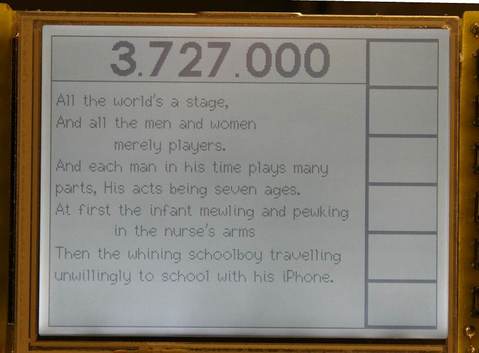
The rather low contrast
Display tech display - rejected.
I have developed the graphics software using the following displays:
Manufacturer: Electronic
Assembly: /http://www.lcd-module.com/
Uk Supplier: MMS Electronics Ltd: http://www.mmselectronics.com/
Data sheet on the modules used: http://www.lcd-module.de/pf/Graf/w320-8k3.pdf
Modules purchased:
EA W320B-8K3LW white on blue
EA W320B-8K3CTP white on blue
In these web pages, I refer to these displays as EA320 displays.
EA320 displays are excellent
with excellent construction.
They are rather expensive.
They are larger than perhaps some builders would wish.
Lower cost displays with the same size, resolution and S1D1370 driver have been successfully used.
Advice on lower cost mono graphics displays from:
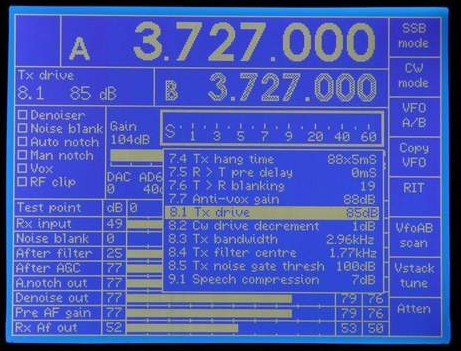
The EA 320x240 CFL
display with touch panel showing DSP monitor mode
and overlaid parameter setting display (press 8 or turn Menu-encoder)
The camera does not do justice to the display - it looks better than this.
The S1D13700 controller display is multi layer. Display modes include:
TrxAVR-Picastar used the three graphics layer mode because:
16 and 8 pixel fonts were
found on the internet. There were supplied coded in C.
They have a width table which I use in proportional spacing.
(Proportional spacing saves width and looks better)
EA320 displays
are currently the basis of the fully featured version of TrxAVR-Picastar
(ie with on-screen labeling of soft buttons, DSP monitor,
stacks&slots list, etc)
We have designed and built an 'EA320 motherboard' to carry:
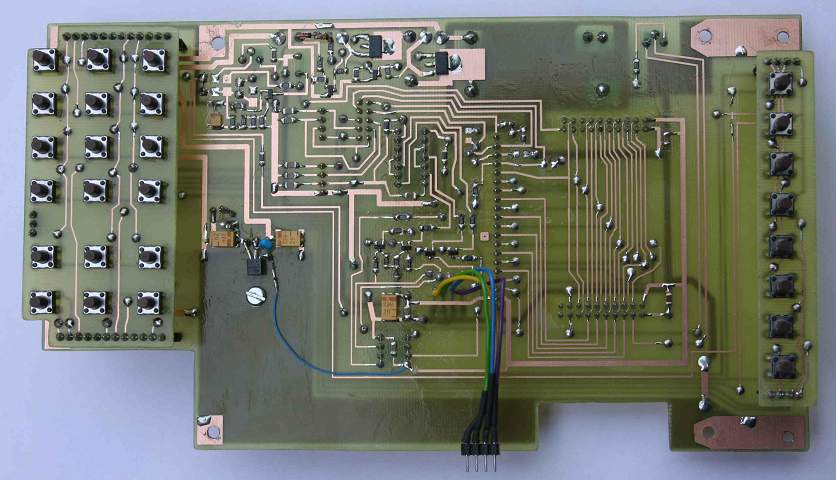
EA320 motherboard
front. (Prototype. The wired 78L08 for touch panel op-amp now incorporated)
4 wire cable at bottom is for Touch panel. Right button board removed if touch
panel present.
Button boards raised to panel level on multiple layers of SIL strip sockets.
Pmosfets at top are for two-level CFL illumination control using DDS 73 (sleep)
and DDS74 (autodim).
(Doubleclick photo for hi-res version)
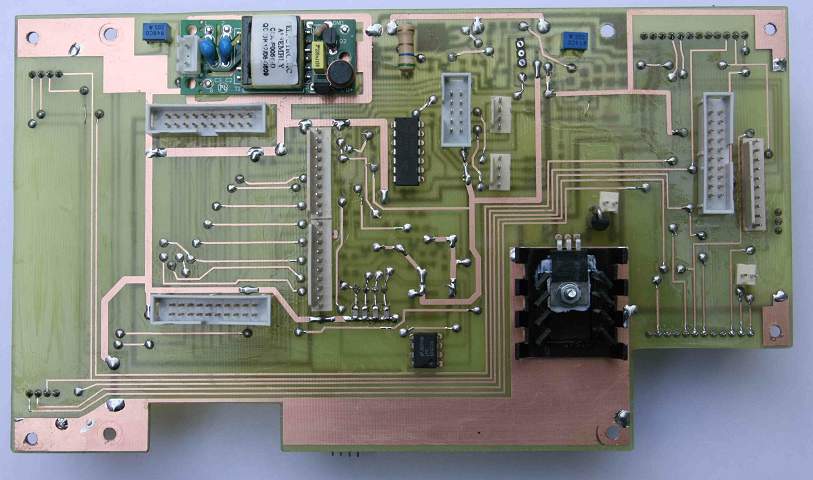
EA320 motherboard
back. Top left is EA inverter (RF inverter interference not detectable)
On board 7805 is for CFL inverter which needs 410mA.
With
LED illumination max current is 190mA and we can use 5v from TrxAVR.)
Dual connectors: IDC for TrxAVRB and 0.1inch SIL for TrxAVR-A.
(Double-click
photo for hi-res version)
We have discovered modules,
seemingly identical to the EA modules on sale by CrystalFontz
at a much lower cost.
See: A
long URL
The CFAG320240CX-TMI-T
model (LED) is priced at $105
The CFAG320240CX-FMI-T mode (CFL) is priced at $123 plus $15 for a inverter.
Our enquiries reveal that they will only deliver using Fedex ( ? $68)
They may not have a touch panel version ?
RF display interference
For a few months, the rig had a finalised front panel but was on a
breadboard.
Initially there was timebase interference from the EA board.
This was completely cured by a thin brass shield between display board and motherboard
(in the mounting pillars)
(I went further and added brass sides - but probably not needed ... maybe I
like soldering brass.
There was a very soft low
level tuning flutter from TrxAVR - less than S1 - ie S meter doesn't move.
There is a similar flutter when in DSP monitor mode which has alot of display
activity.
It disappeared if you disconnected the display cable from TrxAVR.
The display cable was long and passed above the unshielded H-mode mixer .
... and there were two display cables in parallel, because I was supporting
character and graphics displays for development.
The transceiver is now in a case and there
is no detectable interference from TrxAVR or the front panel display.
Colour TFT display
TrxAVR-Picastar is now working with a colour TFT
display.
The development work was carried out on an intelligent colour TFT display from
Electronic Assembly.
This display is: available currently for 180ukp+VAT
Its datasheet is at: http://www.lcd-module.de/eng/pdf/grafik/ediptft43-ae.pdf
The image below shows the display mounted
on a USB programmer motherboard which provides for programming
of the displays 4Mbyte flash memory from the PC via USB.
(This motherboard is not suitable for use
in a rig because is is bigger than the display and has a
USB-B connector sticking upwards from the top.)
The TrxAVR-Picastar display shown below
has six user defined touch buttons each side.
The standard receive display is at the top and the DSP monitor is showing at
the bottom
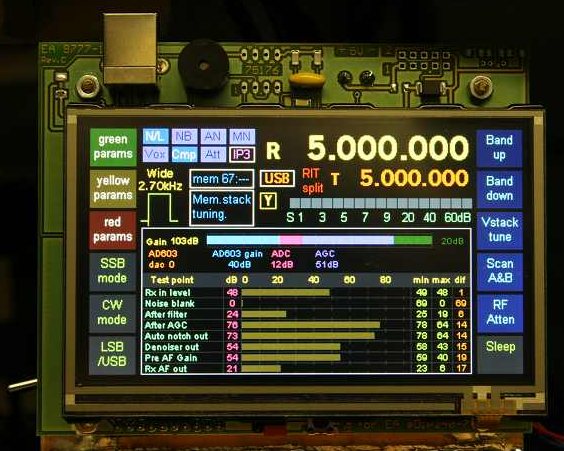
The display is connected to TrxAVR using
the two-wire I2C interfAce (as used by the 24LC512 EEPROM)
The display's flash memory can now be programmed via Hobcat ( PC >
USB > TrxAVR > IC2 >
Display)
Lower cost Colour
TFT Display
Chris Stake
has designed a controller board using an Epson display driver chip and an
Atmel ATmega2560 processor. This is too small and intricate for home PCB manufacture.
Commercially manufactured prototype board have been assembled so that software
development
can begin.
This baord will commuinicate
with TrxAR using the I2C, two wire interface and
the same command sequences as used with the EA display. Our intention therefore,
is
that identical, standard TrxAVR-Picastar code will drive both the EA and the
Chris Stake
controllers.
For more information on colour TFT display development see: TFT displays
For TrxAVR-Picastar colour TFT screen shots see Colour TFT screenshots
128x64 graphics display
128x64 mono graphics was the last
to be developed (September 2009).
The supported displays use the KS0108 (UC0108) graphics control chips.
These displays can be obtained on eBay and from Crystalfonz and elsewhere for
30usd or less.
For more information on 128x64 displays see: 128x64 mono-graphics and screenshots